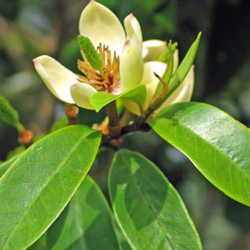Loropetalum is an evergreen broadleaf shrub or small tree that blooms in early spring. During the rest of the year, the rubrum variety has attractive burgundy or bronzy to pink foliage interspersed with, or sometimes turning mostly green. Leaves placed alternately along the stem are simple, ovate, one to two inches long and about an inch wide. Branches held outward in horizontal layers display the flowers and colorful foliage to their best advantage. Flowers have four straplike petals less than an inch long, but they are crowded together in groups of three to six or more in the leaf axils. Flowers are sometimes followed by a woody capsule that holds the seeds. 
Cultural Preferences and General Maintenance
Loropetalum prefers moist, slightly acidic, well-drained soil. Conditions that suit azaleas are generally good for loropetalum, except that the loropetalum appreciates a bit more sun than azaleas. They do well in full sun to light or partial shade. A two-to three-inch layer of organic mulch will help to conserve moisture, which should be maintained for best performance.
Although lorapetalum takes well to pruning and can be maintained as a hedge at almost any height, it has a naturally arching, tiered look that can be lost when pruned into meatball shapes. It is best to plant loropetalum in a place where no pruning is necessary. However, if pruning is needed, tackle the task in spring after the flowers fade. Try to maintain the natural form by reaching deep into the shrub and pruning out selected branches. Then tip prune the remaining branches as needed to maintain the desired size.
An application of fertilizer formulated for azaleas and camellias will promote the acid soil that loropetalum prefers. Many gardeners prefer to rake back the mulch and sprinkle the fertilizer lightly out to the dripline of the shrub. Others simply sprinkle the fertilizer on top of the mulch and water in thoroughly. I prefer the second approach, as it is easier and there is less worry about damaging tender feeder roots that lie near the soil surface.
Propagating Loropetalum
Layering is an easy means of propagation with most loropetalums, as limbs grow near the ground. It is simple enough to wound the bottom of a limb and put it in contact with the soil by pinning it down or placing a rock or brick over it to hold it in place. Treated this way, rooted limbs can be removed the following season. 
Cuttings can be taken about midsummer from the current season's growth. Take tip cuttings of well hydrated plants, and place them in water if they are not being struck immediately. As soon as possible, place the cuttings in damp potting soil. A dip in rooting hormone may encourage rooting. Maintain moisture, but be sure that the soil is well-drained so that your cuttings won't rot before they strike roots. Over-winter the cuttings in a protected place. They should be ready to plant in a larger container or in the landscape by the following spring.
Seedlings may appear underneath established shrubs. These can be removed and potted up or planted in other places in the landscape.
Loropetalum in the Garden
Give considerable attention to where this shrub is placed in the landscape. With most cultivars, the foliage is a reddish or purplish color. In spring, the bright magenta-colored flowers are apt to clash with most other flowers that bloom at the same time. While it is bright enough in the early spring when it is adorned with the colorful flowers, the dark-foliaged selections can lend a dark feeling to a landscape if too many are planted.
Remember, too, that many selections can grow from 10 to 15 feet tall or more in about ten years. The pretty little shrub that you purchase at the nursery may give you grief in later years if it is poorly sited. Conversely, it can be a long-lived, beautiful addition to your landscape if it is placed correctly. It makes a beautiful specimen plant and can even be pruned into a small, multitrunked tree by removing the lower branches.
| Cultivars of Loropetalum
Loropetalum chinense has white flowers, but L. chinense var. rubrum has the colorful flowers that have made the species so popular. Mature size is approximate and is influenced by growing conditions. Names are confused in the trade, and some with different names are actually the same. In addition, some have been given trademark names that are different from the cultivar name. Below are some of the most well-known cultivars. ‘Burgundy' - One of the earliest cultivars; introduced into North America in the late 1980's. Rich, reddish purple foliage that matures to dark green with a purplish cast; dark pink flowers; 14+ feet tall. ‘Blush', RazzleberriTM, ‘Piroche Form', ‘Daybreak's Flame' - Also an early introduction; light, pink-tinged leaves with paler, rose-colored flowers; 6 feet tall and about as wide.. ‘Ruby' - Shiny, ruby-red new growth; compact form tops out at 4 to 5 feet tall and wide ‘Bicolor' - Vigorous cultivar with deep maroon leaves turning to dark olive green as the season progresses; white flowers with light pink streak ‘Fire Dance' - Reddish purple new growth changing to green as season progresses; hot pink flowers; 3-6 feet tall. ‘Hines Purpleleaf', Plum DelightTM, ‘Hines Burgundy', PizazzTM - New growth rosy red aging to dark bronze. Dark rose-colored flowers. 6-8 feet tall. ‘Sizzlin' Pink' - reddish purple new growth matures to purple-green; hot pink flowers; 4-6 feet. ‘Suzanne' - Reddish purple new growth; compact habit; leaves are more rounded than species; medium-pink flowers. To 5 feet tall. ‘Zhuzhou Fuscia' - Blackish maroon leaf color that persists into summer. Deep pink flowers. Large - up to 10 feet tall. ‘Pipa's Red' - Very dark purple foliage; bright pink flowers. Compact to 5 feet tall. |
 |
 |
 |
| Loropetalum chinense var. rubrum 'Ruby' | L. chinense var. rubrum 'Purple Pixie' | L. chinense var. rubrum 'Blush' |
|
At a Glance Scientific name: Loropetalum chinense var. rubrum Pronunciation: lor-oh-PET-al-um chi-NEN-see (variety) ROO-brum Hardiness: USDA Zones 7-10 Family: Hamamelidaceae (witchhazel) Common names: Chinese witchhazel, fringe flower, Chinese fringe flower Origin: China, Japan, and southeastern Asia Relatives: Hamamelis (witch hazel), Liquidambar styraciflua (sweetgum) Propagation: Seeds; cuttings; layering of lower limbs |
| Thanks to htop for her image of Loropetalum seed pods. All other images are the author's. |
















